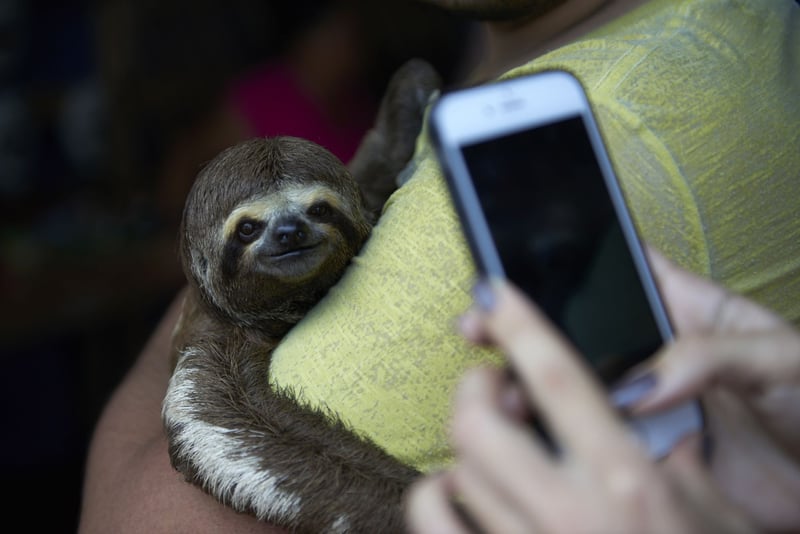
10 Things You Should Know Before You Take a Wildlife Selfie
News
For many people, wildlife selfies are an important part of our holidays, but many that contain wild animals have a darker side.
Many people take these sorts of pictures because they love animals, not realising the suffering that animal may have endured for their once-in-a-lifetime snap.
As part of our latest campaign focusing on the use of wildlife for selfies in the Amazon, here are 10 things you should know before you pose for a picture with a wild animal.
1. Animals are stolen from the wild
The wild animals that feature as photo props for selfies are often stolen from the wild. This is so that the individuals or organisations that make money from these photo opportunities can have the animals at hand when they need them. It also means that the animals can be taught to obey at an early age.
Many animals are stolen directly from their mother. During this process, the mother is usually killed as she tries to defend her child. This will leave the infant animal confused, disorientated and distressed.
2. They aren’t looked after
The needs of many captive wild animals are ignored, causing suffering and pain.
In venues that offer wildlife selfies in the Amazon, our team found sloths tied up when not needed, green anacondas suffering from dehydration, caiman crocodiles with their mouths held closed by rubber bands and ocelots living in small, barren cages.
As these animals are usually taken from the wild, often from their mothers, their keepers have to take certain measures to make sure they are manageable. Our team saw young caimans and anacondas kept in ice coolers to restrain them, and a tour operator beating an anteater to make it submit.
3. Yours isn’t the only selfie
Many selfies taken by tourists will be posted online and forgotten about. But the animals used as photo props can be handled by 200-400 tourists a day, which means they are subject to rough handling, flash photography and loud noises again and again. This results in high levels of stress and a risk of injury for these animals, often to a fatal degree.
4. Animals are kept until they die
Captive animals are kept for photo props until they can no longer be used. Highly sensitive baby sloths used for selfies in the Amazon usually die after around 6 months due to stress and ill health, whereas in the wild they can live up to 30 years.
5. Animal behaviour can be misleading
Because dolphins and sloths look happy, many tourists assume that they are.
Sloths in particular are often misunderstood. They are known to reach out when being passed around, as if asking for a hug, and have facial markings that makes it look like they are smiling. In reality, they are reaching in fear and behind the ‘smile’ lies malnutrition, stress and confusion.
6. The problem is widespread
There are currently 550,000 wild animals being kept captive for the sake of tourist entertainment. During a study on wildlife selfies, it was found that 54% of 249 online attractions offered the chance to handle animals for photos and selfies.
With these operations advertising a total of 72 different species, it’s clear that the demand for wildlife selfies is high, which will mean that more and more animals will continue being taken from the wild.
7. It’s illegal
Although some laws have been put in place to prevent the exploitation of animals via wildlife selfies, much of the industry is unregulated and unsupervised. This serves as a loophole for many operations to cut corners on adequate animal care and handling.
Shockingly, 61% of the species identified in our research are classified as needing international legal protection by the Convention on the Trade of Endangered Species (CITES) and 21% of them are classified as “threatened” by the International Union for the Conservation of Nature (IUCN).
8. The captivity can come in different forms
Not only are animals kept in small cages or tied to trees to prevent them from escaping, operations also exploit natural habitats for financial gain. This includes a technique known as ‘baiting’, which in the Amazon is often used to lure botos, a pink-nosed dolphin, into an area where tourists can handle them.
Although technically free roaming, these dolphins have still become subject to the wildlife selfie industry. Research shows that many of the dolphins have sores under their fins from human contact, and have scratches and bites where they have fought with other dolphins for the bait.
9. There are alternatives
When properly managed, wildlife tourism can hold a range of benefits for both the environment and wild animals. This includes the funding of the protection of natural areas, as well as improving animal welfare and alleviating poverty.
There are animal friendly tour operators that arrange for you to see animals in the wild, which means you can still enjoy all the aspects of local wildlife without having a hand in cruelty and exploitation. There are options that allow you to enjoy animals as they should be, in the wild.
10. You can help stop wildlife selfie cruelty
Reduce the demand that is fuelling the wildlife selfie industry by signing our Wildlife Selfie Code. Share this Code to help raise awareness of this issue and help us persuade social media sites, such as Instagram, to take action against cruel wildlife selfies. Sign wildlife selfie code.
There are currently 550,000 wild animals being kept captive for the sake of tourist entertainment.